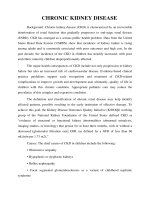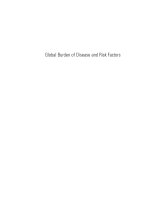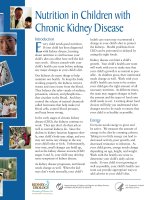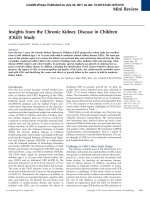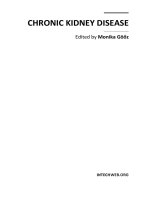CHRONIC KIDNEY DISEASE AND RENAL TRANSPLANTATION ppt
Bạn đang xem bản rút gọn của tài liệu. Xem và tải ngay bản đầy đủ của tài liệu tại đây (11.81 MB, 236 trang )
CHRONIC KIDNEY
DISEASE AND RENAL
TRANSPLANTATION
Edited by Manisha Sahay
Chronic Kidney Disease and Renal Transplantation
Edited by Manisha Sahay
Published by InTech
Janeza Trdine 9, 51000 Rijeka, Croatia
Copyright © 2012 InTech
All chapters are Open Access distributed under the Creative Commons Attribution 3.0
license, which allows users to download, copy and build upon published articles even for
commercial purposes, as long as the author and publisher are properly credited, which
ensures maximum dissemination and a wider impact of our publications. After this work
has been published by InTech, authors have the right to republish it, in whole or part, in
any publication of which they are the author, and to make other personal use of the
work. Any republication, referencing or personal use of the work must explicitly identify
the original source.
As for readers, this license allows users to download, copy and build upon published
chapters even for commercial purposes, as long as the author and publisher are properly
credited, which ensures maximum dissemination and a wider impact of our publications.
Notice
Statements and opinions expressed in the chapters are these of the individual contributors
and not necessarily those of the editors or publisher. No responsibility is accepted for the
accuracy of information contained in the published chapters. The publisher assumes no
responsibility for any damage or injury to persons or property arising out of the use of any
materials, instructions, methods or ideas contained in the book.
Publishing Process Manager Maja Kisic
Technical Editor Teodora Smiljanic
Cover Designer InTech Design Team
First published February, 2012
Printed in Croatia
A free online edition of this book is available at www.intechopen.com
Additional hard copies can be obtained from
Chronic Kidney Disease and Renal Transplantation, Edited by Manisha Sahay
p. cm.
ISBN 978-953-51-0003-4
Contents
Preface IX
Part 1
Chronic Kidney Disease
1
Chapter 1
Screening for Chronic Kidney Disease
Ross Francis and David Johnson
Chapter 2
The Role of Renin Angiotensin System Inhibitors
in Renal Protection: Lessons from Clinical Trials 17
Ljuba Stojiljkovic
Chapter 3
Parathyroid Hormone-Related Protein as a
Mediator of Renal Damage: New Evidence from
Experimental as well as Human Nephropathies 31
Ricardo J. Bosch, María Isabel Arenas, Montserrat Romero,
Nuria Olea, Adriana Izquierdo, Arantxa Ortega, Esperanza Vélez,
Jordi Bover, Juan C. Ardura and Pedro Esbrit
Chapter 4
Psychological and Social Aspects
of Living with Chronic Kidney Disease 47
Daphne L. Jansen, Mieke Rijken, Monique J.W.M. Heijmans,
Ad A. Kaptein and Peter P. Groenewegen
Chapter 5
Role of Fermentable Carbohydrate
Supplements in the Course of Uremia
Hassan Younes
Chapter 6
Chapter 7
3
75
Phosphorus and Calcium Metabolism
Disorders Associated with Chronic Kidney Disease
Stage III-IV (Systematic Review and Meta-Analysis)
L. Milovanova, Y. Milovanov and A. Plotnikova
Recent Trials in Hypertension 119
Samra Abouchacra and Hormaz Dastoor
95
VI
Contents
Chapter 8
Cardiac Biomarkers in End-Stage Renal Disease 147
Leo Jacobs, Alma Mingels and Marja van Dieijen-Visser
Chapter 9
Cardiovascular Complications in Renal Diseases
Mohsen Kerkeni
Part 2
161
Transplantation 169
Chapter 10
Laparoscopic Transperitoneal and Retroperitoneal
Nephrectomies in Children: A Change of Practice 170
Julio J. Báez, Gaston F. Mesples and Alfredo E. Benito
Chapter 11
Mechanisms of Calcineurin Inhibitor
Nephrotoxicity in Chronic Allograft Injury 191
Craig Slattery, Hilary Cassidy, Olwyn Johnston,
Michael P. Ryan and Tara McMorrow
Chapter 12
Malignancy Following Renal Transplantation 213
A. Vanacker and B. Maes
Preface
The first section deals with chronic kidney disease (CKD). CKD is assuming epidemic
proportions. Metabolic bone disease is an important complication of CKD.
Parathormone is an important uremic toxin and plays an important role in the
pathogenesis of renal osteodystrophy and vascular calcification in chronic kidney
disease. The role of elevated calcium and phosphorus product in the genesis of
mineral bone disease is discussed. The presence of kidney disease, manifested by low
glomerular filtration rates (GFR) and/or large amounts of protein in the urine, is
independently associated with increased rates of cardiovascular disease (CVD). The
severity of kidney disease is associated with graded increases in the risk of CVD and
death. This is described in the chapter on cardiovascular diseases in CKD. Chronic
kidney disease affects not only physical but also psychological health and well-being;
this is highlighted in the chapter on social and psychological aspects of chronic kidney
disease. Prevention of chronic kidney disease is the only solution to stem the
increasing prevalence of CKD globally and hence emphasis should be on evolving
screening methods for early detection, as is discussed in the chapter on screening for
chronic kidney disease. The role of renin angiotensin system in the progression of
renal diseases is stressed. The second section of the book includes chapters on renal
transplantation that will be of use to the readers. I am sure this book will be a valuable
addition to the reader’s library.
Dr. Manisha Sahay
Department of Nephrology
Osmania General Hospital & Osmania Medical College
Hyderabad
India
Part 1
Chronic Kidney Disease
1
Screening for Chronic Kidney Disease
Ross Francis and David Johnson
Department of Nephrology
Princess Alexandra Hospital, Woolloongabba, Brisbane
Australia
1. Introduction
Chronic kidney disease (CKD), defined as reduced excretory kidney function (glomerular
filtration rate (GFR) <60 mL/min/1.73m2) or evidence of kidney damage (such as proteinuria)
for a period of at least 3 months, is considered a major global public health problem (Levey,
Atkins et al. 2007). The prevalence of CKD has been estimated at between 10-15% in
industrialised countries and is increasing, likely as a result of population ageing and the
increasing incidence of diabetes, vascular disease and obesity (Chadban, Briganti et al. 2003;
Coresh, Astor et al. 2003; Coresh, Selvin et al. 2007; Stevens, O'Donoghue et al. 2007).
A definition and staging system for CKD was introduced in 2002 and has been widely
accepted (Table 1) (K/DOQI 2002).
Stage
1
2
3
4
5
Description
Kidney damage with normal or increased GFR
Kidney damage with mild reduction in GFR
Moderate reduction in GFR
Severe reduction in GFR
Kidney failure
GFR (ml/min/1.73m2)
≥90
60–89
30–59
15–29
<15 (or dialysis)
Table 1. National Kidney Foundation CKD classification (K/DOQI 2002)
More recent staging classification systems have attempted to improve CKD risk
stratification by incorporating proteinuria (Table 2). Within the continuum of patients with
CKD, there is a wide range of disease severities, from patients with an excellent long-term
renal prognosis through to patients with end-stage kidney disease (ESKD) who require renal
replacement therapy.
Many patients with CKD follow a predictable clinical course following disease initiation,
with progressive renal dysfunction ultimately resulting in ESKD. Critically, CKD is
clinically silent in up to 90% patients until it has reached an advanced stage (Chadban,
Briganti et al. 2003; John, Webb et al. 2004; Nickolas, Frisch et al. 2004), and patients who
reach ESKD without prior contact with nephrology services experience greater co-morbidity
and poorer survival following initiation of renal replacement therapy (Roderick, Jones et al.
2002; Chan, Dall et al. 2007). There is therefore an opportunity to detect patients with
asymptomatic CKD by screening, with the aim of applying therapies to ameliorate disease
progression.
4
Chronic Kidney Disease and Renal Transplantation
Albuminuria Stage (uACR value)
Normal
Microalbuminuria
Macroalbuminuria
(<2.5 mg/mmol [M],
<3.5 mg/mmol [F])
eGFR Stage
(2.5-25 mg/mmol [M],
3.5-35 mg/mmol [F])
(>25 mg/mmol [M],
>35 mg/mmol [F])
1
2
3a
3b
4
5
* Risks of progressive CKD denoted as low (light grey), moderate (dark gray) and high (black).
Table 2. Modified CKD staging system recommended by the Caring for Australasians with
Renal Insufficiency Early CKD Guidelines (Johnson and Toussaint 2011)
Apart from the risk of progression to ESKD, the presence of CKD is a potent risk factor for
cardiovascular disease, such that individuals with ESKD have up to a 10- to 20-fold greater
risk of cardiac death than age- and sex-matched controls without ESKD (Foley and Parfrey
1998). Moreover, as illustrated in Figure 1, people with earlier stages of CKD are up to 20
times more likely to die, predominantly from cardiovascular disease, than survive to
the point of needing dialysis or kidney transplantation (Go, Chertow et al. 2004; Smith, Gullion
Fig. 1. Five-year event rates for all-cause mortality and end-stage kidney disease in CKD
stages 2 to 4 (data derived from (Keith, Nichols et al. 2004)).
Screening for Chronic Kidney Disease
5
et al. 2004; Foley, Murray et al. 2005; Matsushita, van der Velde et al. 2010). As a result, a
successful CKD screening programme would identify individuals who are likely to benefit
from interventions to reduce heart disease risk.
Despite the theoretical benefits, screening for CKD remains controversial (Glassock and
Winearls 2008; Grootendorst, Jager et al. 2009), and although several national and
international organisations have made recommendations advocating routine screening for
CKD, details regarding approaches to screening vary. This chapter will examine the role
and cost-effectiveness of screening for CKD and make recommendations regarding the
optimal screening strategy (i.e. who, how, when and what to screen).
2. Methods of screening
The presence of CKD can be readily identified using non-invasive investigations to estimate
glomerular filtration rate and to detect proteinuria. Further information about future risk of
progressive renal disease and ESKD can be obtained from monitoring blood pressure.
2.1 Proteinuria
Proteinuria is an early marker of kidney damage in many forms of renal disease, such as
diabetic nephropathy and glomerulonephritis. Persistent proteinuria has a strong positive
correlation with the subsequent development of ESKD. In a Japanese study of community
mass screening, 193 of 107,192 subjects were identified as requiring RRT after 10 years of
follow-up (Iseki, Iseki et al. 1996). Proteinuria was the strongest predictor of subsequent
need for dialysis, with an adjusted odds ratio (OR) of 14.9 (95% confidence interval (CI) 10.920.2). Similarly, in a US study that followed 1832 subjects with type 2 diabetes for between
5-40 years, 25 reached ESKD (Humphrey, Ballard et al. 1989). The presence of proteinuria at
the time diabetes was identified was the strongest risk factor for reaching ESKD (relative
risk (RR) 12.1, CI 4.3-34).
There is also evidence from controlled trials that proteinuria is a risk factor for CKD
progression. In the modification of diet in renal disease (MDRD) trial, there was a positive
correlation between baseline proteinuria and the rate of decline in GFR (Peterson, Adler et
al. 1995). This association was independent of other risk factors for decline in GFR such as
blood pressure. Similarly, in a trial of 409 patients with type 1 diabetes, proteinuria was the
strongest single risk factor for doubling of serum creatinine (Breyer, Bain et al. 1996).
The presence of proteinuria has also been shown to be an important independent predictor
of subsequent cardiovascular disease, both in patients with diabetes and the general
population (Mogensen 1984; Rossing, Hougaard et al. 1996; Hillege, Fidler et al. 2002;
Romundstad, Holmen et al. 2003; Hallan, Astor et al. 2007).
Taken together, these observations strongly support the inclusion of proteinuria in CKD
screening. The gold standard for assessing urinary protein excretion is a timed 24-hour
urine collection. However, the difficulties of obtaining an accurately timed and complete
urine collection and the inconvenience for the individual performing the collection reduce
the utility of this test as a screening tool. Because the rate of creatinine excretion remains
approximately stable over a 24-hour period, the creatinine concentration in a spot urine
sample can be used as a control for urine concentration, allowing estimation of 24-hour
urinary protein or albumin excretion from the urinary protein:creatinine ratio (uPCR) or
albumin:creatinine ratio (uACR), respectively (Ginsberg, Chang et al. 1983). Alternatively,
urine stick can be used to estimate urinary protein excretion (James, Bee et al. 1978; Allen,
6
Chronic Kidney Disease and Renal Transplantation
Krauss et al. 1991; Higby, Suiter et al. 1995). However, meta-analysis of data extracted from
the primary studies of proteinuria assessment indicate that urine stick testing has a
sensitivity of 90% and specificity of 67%, compared to a sensitivity of 95% and specificity of
91% for protein:creatinine ratio (Craig, Barratt et al. 2002). For this reason, uPCR or uACR
are the preferred modalities for CKD screening.
There is diurnal variation in urinary protein excretion, with the highest level of proteinuria
in the afternoon and therefore where possible, spot urine testing for proteinuria should be
performed on an early morning (first urinary void of day) sample. However, a number of
studies have demonstrated that random urine samples are still acceptable if first void
samples are impractical (Price, Newall et al. 2005; Cote, Brown et al. 2008; Witte, Lambers
Heerspink et al. 2009). Importantly, transient increases in urinary protein excretion are seen
in several circumstances other than CKD, including urine infection, febrile illness, heart
failure and hyperglycaemia (Table 2). As a result, patients should only be labelled as having
CKD if proteinuria persists for at least three months.
Urinary tract infection
High dietary protein intake
Congestive cardiac failure
Acute febrile illness
Heavy exercise within 24 hours
Menstruation or vaginal discharge
Drugs – e.g. non-steroidal anti-inflammatory drugs, ACE inhibitors, ARBs,
calcineurin inhibitors
Table 2. Factors that may affect urinary protein excretion
2.2 Renal function
Glomerular filtration rate, or GFR, is determined by the total number of functional
nephrons, and is considered the best overall measure of excretory kidney function.
Furthermore, GFR is central to the current definition of CKD. Several equations have been
derived that permit estimation of GFR from the serum concentration of renally-excreted
endogenous molecules – typically creatinine. Creatinine is both filtered at the glomerulus
and secreted in the proximal tubule, and therefore falls short of being a model molecule
with which to assess GFR. This is particularly significant in patients with low GFRs, in
whom tubular creatinine secretion contributes a greater proportion of total renal creatinine
clearance. Nevertheless, several equations have been generated that allow estimation of
GFR using serum creatinine levels. The first equation to be used widely in clinical practice
was described in 1976 (Box 1) and estimates creatinine clearance (Cockcroft and Gault 1976).
While useful for monitoring the clinical course of an individual patient or making dose
adjustments of medications, the inclusion of body weight as a variable reduces the
applicability of this formula for population screening.
More recent equations have been generated using data from large trials in which
simultaneous data for serum creatinine and GFR measured by the renal clearance of
radioactive isotopes, such as [51Cr]-ethylenediaminetetraacetic acid, [125I]-iothalamate or
[99Tcm]-diethylenetriaminepentaacetic acid, were available. At present, an equation
generated using data from the modification of diet in renal disease trial (Box 2) is in
widespread clinical use for GFR estimation (Levey, Bosch et al. 1999).
7
Screening for Chronic Kidney Disease
Creatinine clearance (ml/min) =
1.23 × 140 –
× 0.85 (
(
(
)
/ )
)
Box 1. Cockcroft and Gault equation
GFR (ml/min/1.73m2) =
175 ×
(
1.004
/ )
.
× 0.011312
× 0.742(
× 1.212 (
×(
)
.
)
)
Box 2. Simplified modification of diet in renal disease (MDRD) formula
An advantage of the MDRD equation over the Cockcroft-Gault equation is that the former
only requires knowledge of the serum creatinine, age and ethnicity. MDRD eGFR is
currently reported automatically whenever a serum creatinine assay is requested in several
countries including Australia and the UK. A significant problem with the MDRD equation
is that the accuracy of the approximation to isotopic GFR varies with renal function. While
it is acceptably accurate in patients with low GFR, it performs less well in patients with
normal or near normal renal function (GFR >60ml/min/1.73m2). The MDRD equation
tends to underestimate GFR in patients with normal or near-normal renal function, which is
of particular concern for the purpose of CKD screening, since this increases the probability
of inappropriately labelling healthy individuals with CKD.
In an attempt to improve GFR estimation, a new creatinine-based eGFR equation was
developed that includes a two-slope “spline” to improve accuracy in patients with good
renal function (Levey, Stevens et al. 2009). Unlike the MDRD formula, which was developed
from a population with CKD, the CKD-EPI formula was developed and validated in a
large heterogeneous population with and without known CKD including subjects with
diabetes, potential kidney donors and transplant recipients. Analyses using the CKD-EPI
equation (Box 3) indicate that it is more accurate than the MDRD equation in individuals
with a GFR >60ml/min/1.73m2, and performs with equivalent accuracy to the MDRD
equation when the GFR is <60 (Levey and Stevens 2010; Stevens, Claybon et al. 2011).
Subsequent epidemiologic evaluations in North American (Matsushita K et al. 2010) and
Australian general population studies (White, Polkinghorne et al. 2010) have shown that the
CKD-EPI equation more appropriately categorises individuals with respect to long-term
clinical risks of end-stage kidney disease, coronary heart disease, stroke and/or all-cause
mortality than the MDRD equation. In particular, 1.9% of the AusDiab study population
was re-classified as not having CKD and such re-classified individuals were predominantly
younger women with a favourable cardiovascular risk profile and absence of significant
albuminuria.
8
Chronic Kidney Disease and Renal Transplantation
GFR (ml/min/1.73m2) =
.
141 × min
,1
× max
,1
)
× 1.018(
× 1.159(
= 0.7,
= 0.9,
× 0.993
)
= −0.329
= −0.411
min = theminimumof
max = the maximum of
or1
or 1
Box 3. Chronic Kidney Disease Epidemiology Collaboration (CKD-EPI) equation
Finally, equations are available that permit estimation of GFR from serum levels of an
alternative renally-excreted endogenous molecule, cystatin C (Stevens, Coresh et al. 2006).
Cystatin C is a 122-amino acid protein ubiquitously expressed in all nucleated cells that is
freely filtered at the glomerulus, whereupon 99% of filtered cystatin C is reabsorbed and
catabolised in the proximal tubule (Tenstad, Roald et al. 1996; Roald, Aukland et al. 2004).
There is some evidence that cystatin C, like creatinine, is secreted in the proximal tubule.
Early data suggest that estimated GFR based either on the serum level of cystatin C or the
combination of cystatin C and creatinine may be more accurate than creatinine-only
equations (Madero, Sarnak et al. 2006; Groesbeck, Kottgen et al. 2008; Kottgen, Selvin et al.
2008; Stevens, Coresh et al. 2008). At present, the relatively high cost of assaying cystatin C
and the need for further validation of the potential benefits over creatinine as a filtration
marker mean that this approach is not ready for use as a screening tool.
2.3 Hypertension
Systemic blood pressure is an important and modifiable risk factor for CKD progression
(Haroun, Jaar et al. 2003). Furthermore, long-term population studies indicate that
hypertension is a potent predictor of subsequent development of ESKD. For instance, in the
Multiple Risk Factor Intervention Trial (MRFIT), a strong graded independent relationship
between blood pressure and later ESKD development was observed (Klag, Whelton et al.
1996). The strength of the association between hypertension and ESKD risk was much
greater for systolic blood pressure than diastolic blood pressure.
It remains unclear whether hypertension (other than accelerated or malignant hypertension)
is causally related to, or a consequence of progressive renal impairment. Furthermore, no
studies have specifically examined blood pressure as a screening tool for detecting patients
with CKD. However, the strong epidemiological link between blood pressure and ESKD
suggests that patients with hypertension should be monitored for the development of CKD.
3. Evidence of benefit from screening for CKD
There is little point in screening for a disease unless interventions are available that can
improve outcomes following diagnosis. Unfortunately, there are no prospective randomised
Screening for Chronic Kidney Disease
9
trials that have addressed whether screening for CKD leads to improvement in important
outcomes such as progression of renal dysfunction or co-morbidity from cardiovascular
disease. Despite this, there is an increasing evidence base to support a range of interventions
in patients with CKD, providing indirect support for identifying these individuals at an earlier
stage of disease. Specific therapies are available for a limited number of renal diseases, such as
recombinant alpha-galactosidase in patients with Fabry disease. Immunosuppressive therapy
can ameliorate disease progression in several immunologically-mediated renal diseases, such
as lupus nephropathy. Importantly however, there are data to support the application of
certain therapies in a broad range of patients with CKD, particularly blood pressure control
and the use of HMG-CoA reductase inhibitors (statins).
3.1 Blood pressure lowering
Multiple studies have evaluated the impact of anti-hypertensive agents in patients with
CKD. There is strong and consistent evidence from these data that antihypertensives, and in
particular agents that inhibit the action of angiotensin II, reduce proteinuria (Gansevoort,
Sluiter et al. 1995; Atkins, Briganti et al. 2005; Kunz, Friedrich et al. 2008; Parving, Persson et
al. 2008), as well as the rate of progression of CKD (Peterson, Adler et al. 1995; Maschio,
Alberti et al. 1996; Giatras, Lau et al. 1997; GISEN 1997; Jafar, Schmid et al. 2001; Strippoli,
Bonifati et al. 2006). These data provide compelling support for blood pressure control in
patients with CKD.
3.2 Lipid lowering
Until the recent publication of the SHARP trial (Baigent, Landray et al. 2011), there were no
primary studies of lipid lowering in patients with CKD that were not on renal replacement
therapy. Many patients with overt CKD were excluded from the early large trials showing a
beneficial effect of statins on all cause mortality in both secondary and primary prevention
studies (Wright, Flapan et al. 1994; Shepherd, Cobbe et al. 1995). Nevertheless, post-hoc
analyses have identified many patients with modest renal impairment that were included in
the trials. These data suggest that within these trials, similar benefits from statin use
occurred in patients with or without modest renal impairment (Shepherd, Kastelein et al.
2008; Navaneethan, Nigwekar et al. 2009). In contrast, two randomised controlled trials
specifically evaluating statin use in patients on dialysis found no evidence of improvement
in mortality or cardiovascular endpoints, despite significant reductions in serum cholesterol
levels (Wanner, Krane et al. 2005; Fellstrom, Jardine et al. 2009). The SHARP trial goes some
way to bridge the gulf between these apparently contradictory findings. 9270 patients with
CKD (serum creatinine >150 μmol/L in men or >130 μmol/L in women) were randomised
to receive simvastatin plus ezetimibe or placebo (Baigent, Landray et al. 2011). The active
treatment group experienced significantly fewer major atherosclerotic events (a composite
endpoint of non-fatal myocardial infarction or coronary death, non-haemorrhagic stroke, or
any arterial revascularisation procedure) – (RR 0.83, 95% CI 0.74–0.94; p=0.0021). There was
no significant difference in mortality rate between the two groups. Overall, these data
indicate that patients with CKD are likely to benefit from statin use.
4. Who should be screened for CKD?
Epidemiological studies indicate that many of the patients identified with CKD have a low
probability of progressing to ESKD. As a result, most of the published guidelines on CKD
10
Chronic Kidney Disease and Renal Transplantation
screening have recommended targeted screening of groups considered to be at high risk of
developing progressive CKD, such as individuals with diabetes or hypertension. This
strategy will increase the cost-effectiveness of screening, at the expense of missing
individuals who could benefit from CKD screening. For example, many individuals will
have unrecognised risk factors for CKD – for example undiagnosed diabetes – and will
therefore be omitted from targeted CKD screening. An 8 year follow-up of a cross sectional
health survey (the HUNT II study) involving 65,604 people (70.6 % of all adults aged ≥20
years in Nord-Trøndelag County, Norway) found that screening people with hypertension,
diabetes mellitus, or age >55 years was the most effective strategy to detect patients with
CKD, such that 93.2% (95% CI 92.4-94.0%) of all CKD patients would be identified resulting
in a number needed to screen of 8.7 (8.5 to 9.0). Nevertheless, the risk of end stage kidney
disease among those detected was low (1.2% over 8 years) (Hallan, Dahl et al. 2006). Other
strategies of targeting (e.g. only people with diabetes and hypertension) detected a lower
percentage of CKD (44.2%) and were less effective. Another study reporting on the
performance of similar screening strategies is the United States (US) Kidney Early
Evaluation Program (KEEP), which targets individuals with diabetes, hypertension, or
family history of diabetes or hypertension or CKD. Using this strategy, 7 people with
diabetes or hypertension or with first degree relatives with diabetes, hypertension or kidney
disease needed to be screened for one case of CKD to be found (Vassalotti, Li et al. 2009).
An Australian report by Howard et al. using cost-effectiveness modelling outlined the
potential effectiveness of screening and intensive management of the most important CKD
risk factors - diabetes, hypertension and proteinuria (Howard, White et al. 2010). Costeffectiveness was modelled in terms of the effect on overall mortality, on cardiovascular
mortality and morbidity and on progression to ESKD and the report determined that a
strategy based on screening of 50 to 69 year olds in general practice, plus intensive
management of diabetes, hypertension and proteinuria, would be cost-effective. Similarly, a
US cost-effectiveness study found that early detection of urine protein to slow progression
of CKD and decrease mortality was not cost-effective unless selectively directed toward
high-risk groups (older persons and persons with hypertension) (Boulware, Jaar et al. 2003).
The CARI Guidelines recommend that patients should be screened with eGFR, urine
albumin:creatinine ratio (uACR) and a BP measurement at least annually during routine
primary health encounters if they have at least one of the CKD risk factors listed in Figure 2.
5. Conclusions
CKD is common, and can be readily detected using non-invasive assays. It causes
considerable co-morbidity and premature mortality, and is frequently asymptomatic until
disease has progressed to the point that there is little scope to modify disease progression or
limit co-morbidity. At present, it is unclear whether screening for CKD has a beneficial
effect on outcome. However, increasing evidence supports a range of interventions in
patients with CKD, including blood pressure reduction, angiotensin-converting enzyme
inhibition or angiotensin receptor blockade to reduce proteinuria and statin use to reduce
cardiovascular events. Therefore, CKD fits many of the principles proposed by the WHO
for population health screening programmes (Table 4). General population screening does
not appear to be a cost-effective approach, and instead screening should be performed in
individuals who have an elevated risk for CKD. An illustrative example of how a CKD
screening programme may be organised is shown in Figure 2.
Screening for Chronic Kidney Disease
Fig. 2. Recommended approach to screening for CKD
11
12
Chronic Kidney Disease and Renal Transplantation
The condition should be an important health problem.
There should be a treatment for the condition.
Facilities for diagnosis and treatment should be available.
There should be a latent stage of the disease.
There should be a test or examination for the condition.
The test should be acceptable to the population.
The natural history of the disease should be adequately understood.
There should be an agreed policy on whom to treat.
The total cost of finding a case should be economically balanced in relation to medical
expenditure as a whole.
Case-finding should be a continuous process, not just a "once and for all" project.
Table 4. World Health Organisation Principles of Screening (Jungner and Wilson 1968)
The clinical priorities in individuals detected to have CKD during screening will vary
depending on the patient population. It is likely that many elderly patients with relatively
poor excretory renal function (CKD stage 4-5) will be identified. However, many of these
individuals are likely to have relatively stable renal function and to die either from
alternative health issues or cardiovascular disease (O'Hare, Choi et al. 2007). In this
population the principal benefit of CKD identification will be the potential to reduce the risk
of cardiovascular complications. Younger patients with CKD are more likely to progress to
ESKD, and the priorities will be both to ameliorate renal disease progression as well as to
reduce cardiovascular co-morbidity (Menon, Wang et al. 2008).
6. Online resources
•
•
•
•
•
•
National Kidney Foundation />Kidney Disease Improving Global Outcomes (KDIGO) />Caring for Australians with Renal Impairment />UK Renal Association />European Renal Association />UK NICE CKD guidelines />
7. References
Allen, J. K., E. A. Krauss, et al. (1991). "Dipstick analysis of urinary protein. A comparison of
Chemstrip-9 and Multistix-10SG." Arch Pathol Lab Med 115(1): 34-37.
Atkins, R. C., E. M. Briganti, et al. (2005). "Proteinuria reduction and progression to renal
failure in patients with type 2 diabetes mellitus and overt nephropathy." Am J
Kidney Dis 45(2): 281-287.
Baigent, C., M. J. Landray, et al. (2011). "The effects of lowering LDL cholesterol with
simvastatin plus ezetimibe in patients with chronic kidney disease (Study of Heart
and Renal Protection): a randomised placebo-controlled trial." Lancet.
Boulware, L. E., B. G. Jaar, et al. (2003). "Screening for proteinuria in US adults: a costeffectiveness analysis." JAMA 290(23): 3101-3114.
Breyer, J. A., R. P. Bain, et al. (1996). "Predictors of the progression of renal insufficiency in
patients with insulin-dependent diabetes and overt diabetic nephropathy. The
Collaborative Study Group." Kidney Int 50(5): 1651-1658.
Screening for Chronic Kidney Disease
13
Chadban, S. J., E. M. Briganti, et al. (2003). "Prevalence of kidney damage in Australian
adults: The AusDiab kidney study." J Am Soc Nephrol 14(7 Suppl 2): S131-138.
Chan, M. R., A. T. Dall, et al. (2007). "Outcomes in patients with chronic kidney disease
referred late to nephrologists: a meta-analysis." Am J Med 120(12): 1063-1070.
Cockcroft, D. W. and M. H. Gault (1976). "Prediction of creatinine clearance from serum
creatinine." Nephron 16(1): 31-41.
Coresh, J., B. C. Astor, et al. (2003). "Prevalence of chronic kidney disease and decreased
kidney function in the adult US population: Third National Health and Nutrition
Examination Survey." Am J Kidney Dis 41(1): 1-12.
Coresh, J., E. Selvin, et al. (2007). "Prevalence of chronic kidney disease in the United States."
JAMA 298(17): 2038-2047.
Cote, A. M., M. A. Brown, et al. (2008). "Diagnostic accuracy of urinary spot
protein:creatinine ratio for proteinuria in hypertensive pregnant women:
systematic review." BMJ 336(7651): 1003-1006.
Craig, J. C., A. Barratt, et al. (2002). "Feasibility study of the early detection and treatment of
renal disease by mass screening." Intern Med J 32(1-2): 6-14.
Fellstrom, B. C., A. G. Jardine, et al. (2009). "Rosuvastatin and cardiovascular events in
patients undergoing hemodialysis." N Engl J Med 360(14): 1395-1407.
Foley, R. N., A. M. Murray, et al. (2005). "Chronic kidney disease and the risk for
cardiovascular disease, renal replacement, and death in the United States Medicare
population, 1998 to 1999." J Am Soc Nephrol 16(2): 489-495.
Foley, R. N. and P. S. Parfrey (1998). "Cardiovascular disease and mortality in ESRD." J
Nephrol 11(5): 239-245.
Gansevoort, R. T., W. J. Sluiter, et al. (1995). "Antiproteinuric effect of blood-pressurelowering agents: a meta-analysis of comparative trials." Nephrol Dial Transplant
10(11): 1963-1974.
Giatras, I., J. Lau, et al. (1997). "Effect of angiotensin-converting enzyme inhibitors on the
progression of nondiabetic renal disease: a meta-analysis of randomized trials.
Angiotensin-Converting-Enzyme Inhibition and Progressive Renal Disease Study
Group." Ann Intern Med 127(5): 337-345.
Ginsberg, J. M., B. S. Chang, et al. (1983). "Use of single voided urine samples to estimate
quantitative proteinuria." N Engl J Med 309(25): 1543-1546.
GISEN (1997). "Randomised placebo-controlled trial of effect of ramipril on decline in
glomerular filtration rate and risk of terminal renal failure in proteinuric, nondiabetic nephropathy. The GISEN Group (Gruppo Italiano di Studi Epidemiologici
in Nefrologia)." Lancet 349(9069): 1857-1863.
Glassock, R. J. and C. Winearls (2008). "Screening for CKD with eGFR: doubts and dangers."
Clin J Am Soc Nephrol 3(5): 1563-1568.
Go, A. S., G. M. Chertow, et al. (2004). "Chronic kidney disease and the risks of death,
cardiovascular events, and hospitalization." N Engl J Med 351(13): 1296-1305.
Groesbeck, D., A. Kottgen, et al. (2008). "Age, gender, and race effects on cystatin C levels in
US adolescents." Clin J Am Soc Nephrol 3(6): 1777-1785.
Grootendorst, D. C., K. J. Jager, et al. (2009). "Screening: why, when, and how." Kidney Int
76(7): 694-699.
14
Chronic Kidney Disease and Renal Transplantation
Hallan, S., B. Astor, et al. (2007). "Association of kidney function and albuminuria with
cardiovascular mortality in older vs younger individuals: The HUNT II Study."
Arch Intern Med 167(22): 2490-2496.
Hallan, S. I., K. Dahl, et al. (2006). "Screening strategies for chronic kidney disease in the
general population: follow-up of cross sectional health survey." BMJ 333(7577):
1047.
Haroun, M. K., B. G. Jaar, et al. (2003). "Risk factors for chronic kidney disease: a prospective
study of 23,534 men and women in Washington County, Maryland." J Am Soc
Nephrol 14(11): 2934-2941.
Higby, K., C. R. Suiter, et al. (1995). "A comparison between two screening methods for
detection of microproteinuria." Am J Obstet Gynecol 173(4): 1111-1114.
Hillege, H. L., V. Fidler, et al. (2002). "Urinary albumin excretion predicts cardiovascular and
noncardiovascular mortality in general population." Circulation 106(14): 1777-1782.
Howard, K., S. White, et al. (2010). "Cost-effectiveness of screening and optimal
management for diabetes, hypertension, and chronic kidney disease: a modeled
analysis." Value Health 13(2): 196-208.
Humphrey, L. L., D. J. Ballard, et al. (1989). "Chronic renal failure in non-insulin-dependent
diabetes mellitus. A population-based study in Rochester, Minnesota." Ann Intern
Med 111(10): 788-796.
Iseki, K., C. Iseki, et al. (1996). "Risk of developing end-stage renal disease in a cohort of
mass screening." Kidney Int 49(3): 800-805.
Jafar, T. H., C. H. Schmid, et al. (2001). "Angiotensin-converting enzyme inhibitors and
progression of nondiabetic renal disease. A meta-analysis of patient-level data."
Ann Intern Med 135(2): 73-87.
James, G. P., D. E. Bee, et al. (1978). "Proteinuria: accuracy and precision of laboratory
diagnosis by dip-stick analysis." Clin Chem 24(11): 1934-1939.
John, R., M. Webb, et al. (2004). "Unreferred chronic kidney disease: a longitudinal study."
Am J Kidney Dis 43(5): 825-835.
Johnson, D. W. and N. Toussaint. (2011). "CARI Guidelines for early chronic kidney disease:
Diagnosis, classification & staging of chronic kidney disease." from
/>ng_Early%20CKD_DNT.pdf.
Jungner, G. and J. M. G. Wilson (1968). "Principles and practice of screening for disease."
WHO Public Health Papers 22(11).
K/DOQI (2002). "K/DOQI clinical practice guidelines for chronic kidney disease:
evaluation, classification, and stratification." Am J Kidney Dis 39(2 Suppl 1): S1-266.
Keith, D. S., G. A. Nichols, et al. (2004). "Longitudinal follow-up and outcomes among a
population with chronic kidney disease in a large managed care organization."
Arch Intern Med 164(6): 659-663.
Klag, M. J., P. K. Whelton, et al. (1996). "Blood pressure and end-stage renal disease in men."
N Engl J Med 334(1): 13-18.
Kottgen, A., E. Selvin, et al. (2008). "Serum cystatin C in the United States: the Third
National Health and Nutrition Examination Survey (NHANES III)." Am J Kidney
Dis 51(3): 385-394.
Screening for Chronic Kidney Disease
15
Kunz, R., C. Friedrich, et al. (2008). "Meta-analysis: effect of monotherapy and combination
therapy with inhibitors of the renin angiotensin system on proteinuria in renal
disease." Ann Intern Med 148(1): 30-48.
Levey, A. S., R. Atkins, et al. (2007). "Chronic kidney disease as a global public health
problem: approaches and initiatives - a position statement from Kidney Disease
Improving Global Outcomes." Kidney Int 72(3): 247-259.
Levey, A. S., J. P. Bosch, et al. (1999). "A more accurate method to estimate glomerular
filtration rate from serum creatinine: a new prediction equation. Modification of
Diet in Renal Disease Study Group." Ann Intern Med 130(6): 461-470.
Levey, A. S. and L. A. Stevens (2010). "Estimating GFR using the CKD Epidemiology
Collaboration (CKD-EPI) creatinine equation: more accurate GFR estimates, lower
CKD prevalence estimates, and better risk predictions." Am J Kidney Dis 55(4): 622627.
Levey, A. S., L. A. Stevens, et al. (2009). "A new equation to estimate glomerular filtration
rate." Ann Intern Med 150(9): 604-612.
Madero, M., M. J. Sarnak, et al. (2006). "Serum cystatin C as a marker of glomerular filtration
rate." Curr Opin Nephrol Hypertens 15(6): 610-616.
Maschio, G., D. Alberti, et al. (1996). "Effect of the angiotensin-converting-enzyme inhibitor
benazepril on the progression of chronic renal insufficiency. The AngiotensinConverting-Enzyme Inhibition in Progressive Renal Insufficiency Study Group." N
Engl J Med 334(15): 939-945.
Matsushita, K., M. van der Velde, et al. (2010). "Association of estimated glomerular
filtration rate and albuminuria with all-cause and cardiovascular mortality in
general population cohorts: a collaborative meta-analysis." Lancet 375(9731): 20732081.
Menon, V., X. Wang, et al. (2008). "Long-term outcomes in nondiabetic chronic kidney
disease." Kidney Int 73(11): 1310-1315.
Mogensen, C. E. (1984). "Microalbuminuria predicts clinical proteinuria and early mortality
in maturity-onset diabetes." N Engl J Med 310(6): 356-360.
Navaneethan, S. D., S. U. Nigwekar, et al. (2009). "HMG CoA reductase inhibitors (statins)
for dialysis patients." Cochrane Database Syst Rev(3): CD004289.
Nickolas, T. L., G. D. Frisch, et al. (2004). "Awareness of kidney disease in the US
population: findings from the National Health and Nutrition Examination Survey
(NHANES) 1999 to 2000." Am J Kidney Dis 44(2): 185-197.
O'Hare, A. M., A. I. Choi, et al. (2007). "Age affects outcomes in chronic kidney disease." J
Am Soc Nephrol 18(10): 2758-2765.
Parving, H. H., F. Persson, et al. (2008). "Aliskiren combined with losartan in type 2 diabetes
and nephropathy." N Engl J Med 358(23): 2433-2446.
Peterson, J. C., S. Adler, et al. (1995). "Blood pressure control, proteinuria, and the
progression of renal disease. The Modification of Diet in Renal Disease Study." Ann
Intern Med 123(10): 754-762.
Price, C. P., R. G. Newall, et al. (2005). "Use of protein:creatinine ratio measurements on
random urine samples for prediction of significant proteinuria: a systematic
review." Clin Chem 51(9): 1577-1586.
Roald, A. B., K. Aukland, et al. (2004). "Tubular absorption of filtered cystatin-C in the rat
kidney." Exp Physiol 89(6): 701-707.

